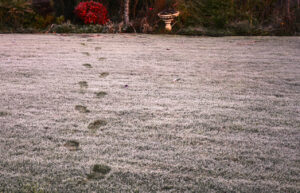Will Frost Kill Grass Seed?
As winter sets in and the days grow shorter, the first widespread frosts of the season have made their appearance. But what happens if you’ve recently sown grass seed and it germinates only to be covered in frost? Does frost pose a threat to newly sown grass seed, and is there anything you can do to protect it? Let’s delve into the details.
Autumn is considered the optimal time for sowing grass seed. During this season, soil temperatures are generally high, and there is ample moisture available to facilitate successful seed germination. This stands in contrast to spring, where ideal seed-sowing conditions can quickly turn unfavourable if the weather becomes hot and dry. However, sowing grass seed in late autumn does carry the risk of encountering cold conditions. The positive news, though, is that newly sown grass seed demonstrates a considerable resilience to frost.
Your grass will be OK!
Young, recently germinated grass plants can withstand periods of air frost typically experienced in autumn. Interestingly, these young plants often maintain a slightly higher temperature than their mature counterparts. This difference is sometimes evident when areas of newly sown grass remain free of frost, contrasting with the ‘white over’ appearance of surrounding mature grass. While extended periods of deep ground frosts may negatively impact young seedlings, such conditions are unlikely in the autumn.
Nevertheless, the onset of frosts contributes to a decrease in soil temperature, slowing down the speed of germination and overall plant growth. This slowdown is a result of the inhibition of various biochemical reactions essential for growth in lower temperatures*. Additionally, cold temperatures can impact the availability of nutrients in the soil, as microbial activity responsible for breaking down organic matter and releasing nutrients slows down in colder conditions. This limitation can affect the essential nutrient supply for grass growth.
Keep off the grass!

Keep off the grass! Walking on frozen grass will damage the leaf and increase the chances of disease taking hold.
If your new grass happens to be hit by frost, it’s crucial to take one important step – stay off it! Ice crystals forming on the plant’s leaves can easily puncture the leaf when walked upon. The consequence is dark footprints that will turn yellow as the leaf dries out when the frost melts. While this damage is superficial and won’t kill the plant, it weakens it, making it more susceptible to diseases.
In summary, while frost may temporarily slow down the growth of newly sown grass and cause superficial damage, proper care and patience can help the plants recover. Avoiding walking on frosted grass and maintaining good lawn care practices will promote healthy growth once the weather conditions improve.
It’s not too late to sow.
Despite the onset of frosts, it’s not too late to sow grass seed! Perennial ryegrass will germinate in soil temperatures from 7 degrees Celsius, and red fescue from 11 degrees Celsius. Today, on the 16th of October, the soil temperature at midday registers at 10.2 degrees. Hence, although fescue may initiate growth slowly, it still falls well within the parameters for ryegrass-based mixtures such as Value Lawn Seed, Hardwearing Lawn Seed, and Multi-Purpose Lawn Seed.
*Hennessy, Deirdre & Hurtado-Uria, Cristina & Shalloo, Laurence & delaby, luc & Connor, Declan. (2013). Relationships between meteorological data and grass growth over time in the south of Ireland. https://www.researchgate.net/publication/269092361_Relationships_between_meteorological_data_and_grass_growth_over_time_in_the_south_of_Ireland